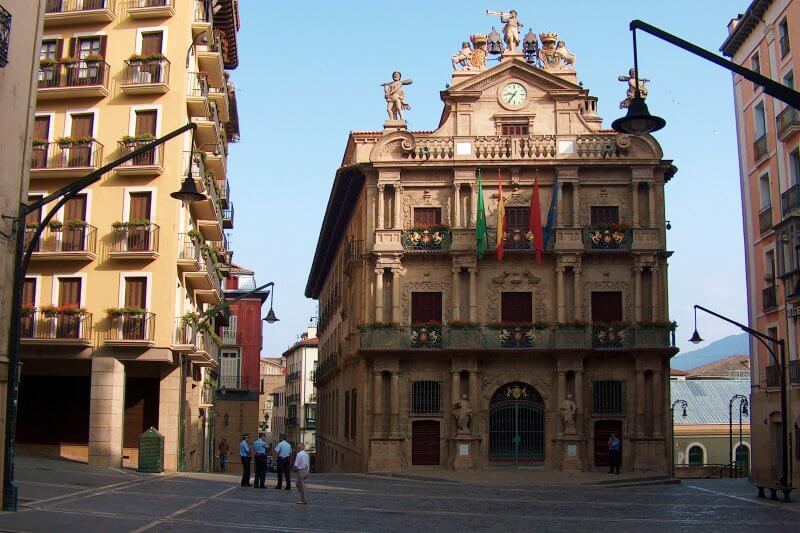Pamplona (Spain) is the capital of the autonomous region of Navarre, located in the northern part of the state. Pamplona is located at the foot of the Western Pyrenees, on the banks of the Arge River. The area of the city is 23.55 km2, and about 198,500 people live on this territory.
Pamplona is one of the most ancient cities in Spain-its history dates back to 74 BC. In addition, Pamplona is also one of the most famous cities in Spain. But this city gained worldwide fame not because of its age and historical attractions, but because of the San Fermin Festival.
Holiday of San Fermin
The festival dedicated to the patron saint of Pamplona, Saint Fermin, has been traditionally held since the 12th century. But gradually the significance of the religious component of this holiday became less and less, and in the twentieth century San Fermin became exactly the festival that can be observed now.
Interesting fact! Every year during San Fermin, Pamplona attracts up to 3,000,000 people not only from all over Spain, but also from all over the world.
The fiesta lasts for a week: it begins on July 6 at 12: 00, when a rocket is launched from the balcony of the city hall. San Fermin is a daily fun folk festivals with music and dancing, carnival parades, performances of street artists, nightly fireworks. But the main event is quite dangerous entertainment Encierro-running through the city streets of people from angry bulls.
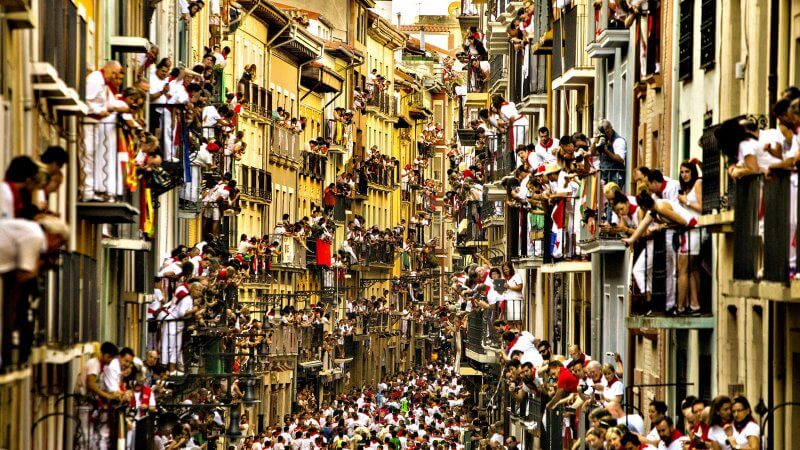
The Pamplona bull run starts on the second day of the Fiesta, July 7. At 7:00, these animals are released from the pen, and they rush madly through the fenced streets of the city to the bullfighting arena. Previously, the bulls were simply led to the arena for fighting, and in 1856, for the first time, what now attracts people to the fiesta most of all happened: hundreds of desperate daredevils run in front of and next to the bulls, risking injury and even death. Such races of bulls and people take place every day for a week while the fiesta lasts.
Important! The most enthusiastic extreme hikers can also take part in encierro, provided that they are already 18 years old and that they are sober. However, it should be borne in mind that the injuries received in this case are not considered an insured event.
The race lasts only 2-3 minutes, its total distance is 849 meters. The paddock is located next to Santo Domingo Square, and the Pamplona bullring is located in Hemingway Square, southwest of the old quarter.
It is not necessary to try your luck in the race with the bulls, because you can just watch Encierro. Thousands of people gather behind fences that protect against these animals. A huge number of people watch the spectacle from the windows, or sitting on the balconies of buildings.
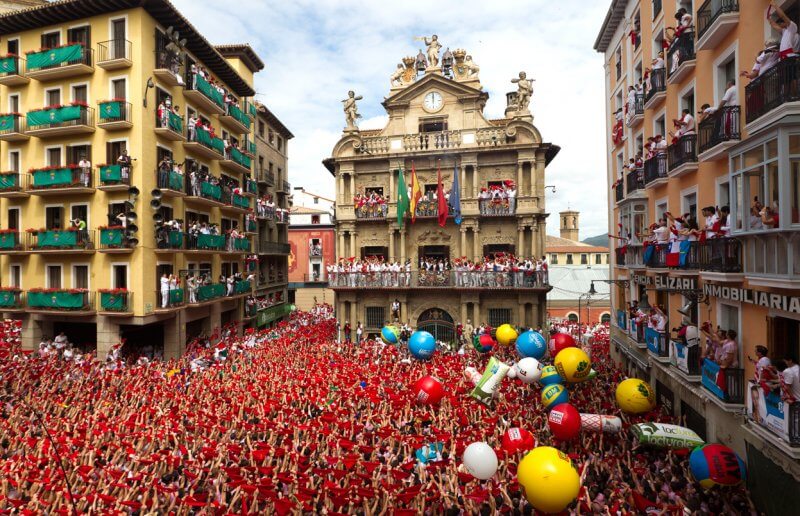
On a note! Rent a place on the balcony that looks out on the street where the bulls are racing, costs from 100 € per person. This price includes wine and snacks.
San Fermin ends up being a much less safe event than a bull run. On the last night of the fiesta, June 14, a solemn mass is held in the cathedral, and thousands of people gather in the square in front of the cathedral. They hold lighted candles in their hands, which makes the square look like a huge sea of fire. encierro
Interesting fact! In 1923, Ernest Hemingway visited Pamplona during San Fermin. The writer was so shocked by the bull race that he wrote the story “And the Sun Rises” about it. It was Hemingway’s book that brought Fiesta and Encierro worldwide fame.
City attractions
Given the fact that Pamplona has existed for more than one century, it is quite logical that there are many historical attractions in this city. While walking through the beautiful old streets, the meaning of the phrase “Pamplona is not only San Fermin” becomes clear. Although among the attractions of Pamplona there are also those that are dedicated to this festival.
Monument “Running of bulls”
The Encierro sculpture group is the hallmark of Pampluna, which is famous both in Spain and around the world for running bulls. This landmark is located in the center of Pamplona, on the Avenida Roncesvalles.
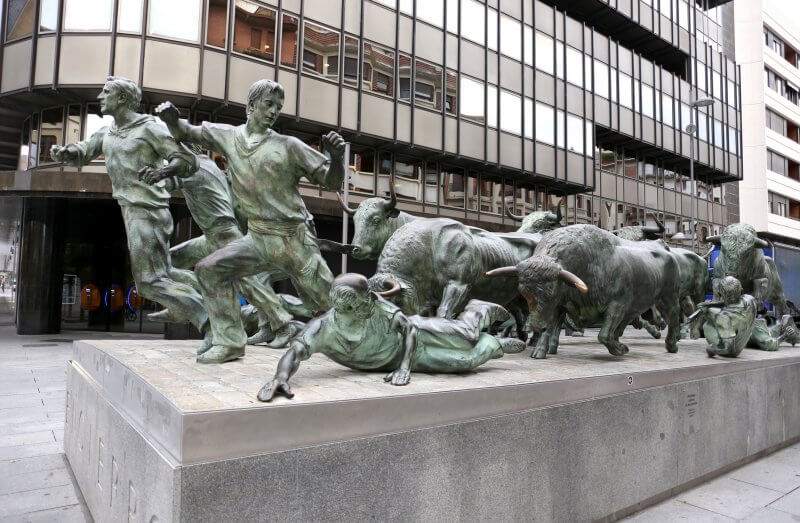
Interesting fact! The weight of the monument exceeds 30 tons, its dimensions are 11 x 4 meters, and the project cost is 661,113 euros.
The Encierro monument, which has become an iconic landmark in Pamplona, is characterized by a very realistic design. People, animals-all in full size, with the smallest details. The author managed to convey the emotions and atmosphere of Encierro in motion: rushing angry bulls, running men, whose facial expressions convey all the tension of the moment.
Interesting fact! Sculptor Rafael Huerta captured himself in one of the runners: the third one on the right side, the one who fell and looks in the direction of the bulls.
Tourists visiting the city of Pamplona in Spain take photos not only near the monument – many climb on bulls on horseback. And you can also make a wish and hold on to the bull’s horn, already polished to a golden shine-they say that the wish will definitely come true.
Central Square of Castillo
Before the new arena was built in 1922, it was the Plaza del Castillo that hosted the bullfights.
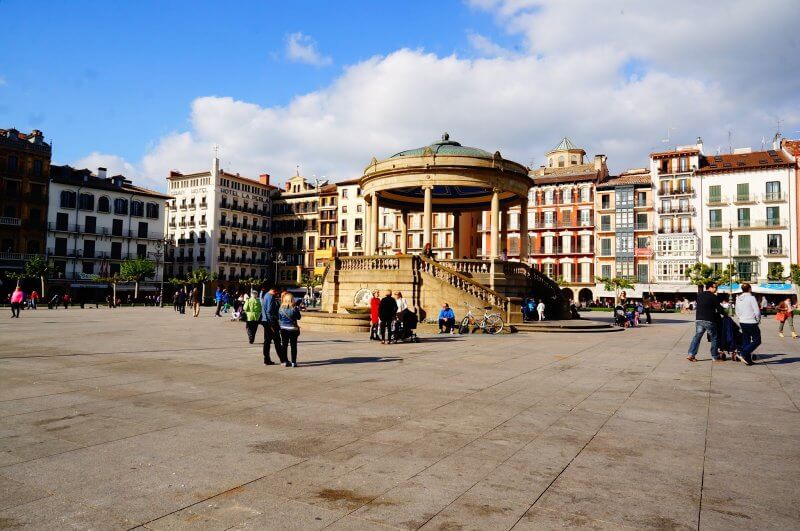
Now Castillo Square is the center and heart of Pamplona, where citizens like to relax. It is from here that the routes to the main tourist attractions diverge.
Like many central squares in Spain, Plaza del Castillo is surrounded around the perimeter by old buildings of various heights with arcades. Among them there are palaces, theaters, hotels, casinos, shops, and numerous residential buildings. There are a lot of cafes and restaurants.
There is still a cafe “Iruna”, which is rightfully considered one of the attractions of Pamplona and Spain. Ernest Hemingway liked to visit this cafe. Now there is a statue of the writer inside, and the interior has remained unchanged since the XIX century.
City Hall
In the historic center, on the small Plaza Consistorial, there is another city landmark: Town Hall.
The Town Hall looks quite impressive. Double columns divide the slightly elongated facade into 3 parts, and stone statues of Prudence and Justice are installed at the entrance to the building. The entire facade is stuccoed, at the top is a balustrade, on the roof there are sculptures of lions and an angel with a trumpet. On the second and third floors there are beautiful balconies-one of them proclaims the beginning of San Fermin.
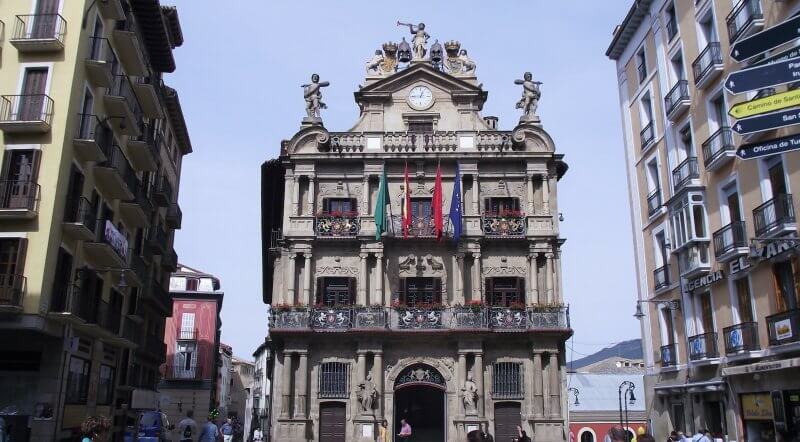
Numerous restaurants and souvenir shops can be found near this landmark in the Consistorial Square.
Cadiz, Spain: Exploring the Rich Heritage of Europe’s Oldest City
St. Mary’s Cathedral
The Cathedral of Santa Maria la Real is a majestic church structure in the Gothic style, striking for its monumentality and massiveness.
The interior of the cathedral is very rich, there are many real works of art and historical attractions:
- high windows with beautiful airy stained glass windows;
- altarpieces and sculptures in the chapels of St. John the Baptist (left behind the baptistery) and Sandoval (in the gallery);
- wood-carved and silver-plated Romanesque sculpture of the Holy Virgin Mary;
- the famous cloister of the XIII century with a covered gallery on the 2nd floor;
- spiral staircase leading to the 2nd floor;
- tomb of King Charles III of Navarre and his wife;
- retablo in side chapels: 2 Gothic, 5 Baroque, 2 Renaissance.
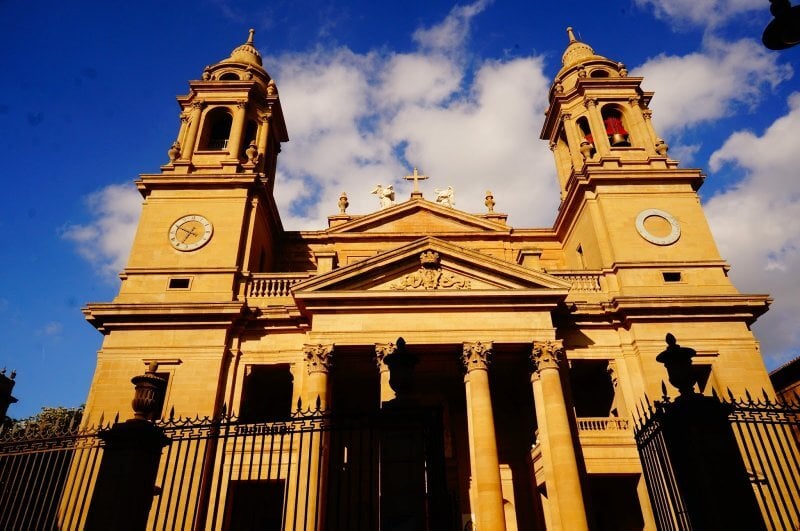
A Diocesan Museum is now open in the former canons ‘ rooms. The museum exhibits religious art from many churches in Navarre: paintings and sculptures of the Romanesque, Gothic, Renaissance and Baroque eras, as well as gold and silver products of the XIII-XVIII centuries.
Practical information
There is a fee for admission to the cathedral and the museum with its attractions:
- for adults 5 €;
- for children from 7 to 13 years – 3 €;
- for children over 13 years of age, students and pensioners – 4 €.
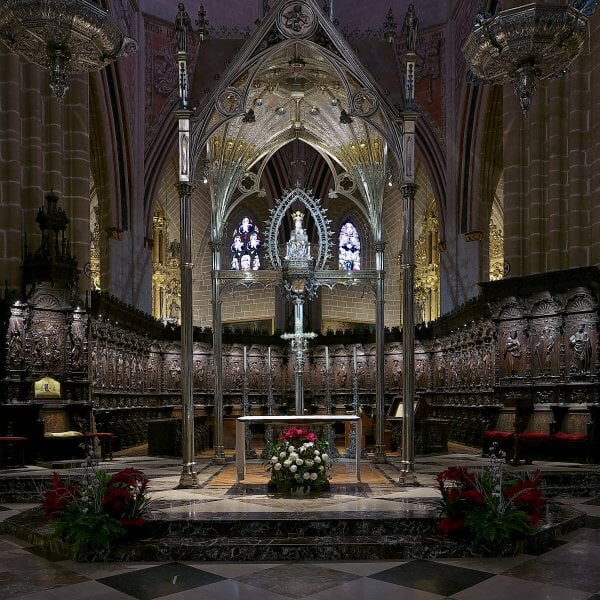
The cathedral is closed on Sundays, but on other days it operates according to the following schedule::
- from the last week of March to the last week of October: from 10: 30 to 19: 00;
- from the last week of October to the last week of March: from 10: 30 to 17: 00;
- in any season, on Saturdays and holidays, the cathedral’s sights can be viewed with a guided tour-starting at 12: 00;
- ascent to the bell tower-daily from 11: 00 to 15: 00 by appointment.
Address of the religious attraction: Calle Dormitalería, 1, 31001 Pamplona, Navarra, Spain.
Official website: http://www.catedraldepamplona.com/catedral/.
Fort in the Vuelta del Castillo Park
The Vuelta del Castillo Park and the old fortress are not the most important sights of Pamplona, but if you have time, you should also visit this place.
The fort, built in 1571-1645 for the defense of the city, is not located on a hill, like most ancient fortresses. In addition, this defensive structure has a very interesting layout: it is made in the form of a star, at each end of which, if necessary, soldiers could take up combat positions. The enemy could not see this fortress when approaching the city, but from the fortress itself it was possible to control all the actions of the attackers well.
The total area of the attraction-the ancient fort and the surrounding Vuelta del Castillo Park-is about 280 000 m2. Today, the entire territory of the fortress – pavilions, bastions, moats-is used for cultural recreation, sports and other events.
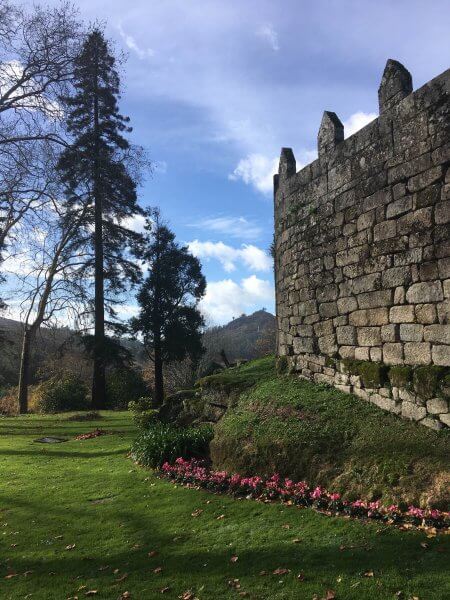
Trees were planted between different parts of the structure, flower beds and mowed lawns were laid out. In the courtyard, a park with flower beds and a network of paths was also organized, a fountain and a playground were built on a small central square, benches were installed. There are cafes and museums here.
The oldest building of the historical landmark, the Polvorin powder depot, is now used for art exhibitions. The bakery premises were also converted into an exhibition hall. A variety of cultural events are organized in the 4-storey armory.
Place of interest: Avenida del Ejercito 1, 31001 Pamplona, Navarra, Spain.
Pamplona accommodation
If you compare with other cities in Spain, then in Pamplona prices for accommodation can be called average. For such a flow of tourists, which is observed here throughout the year, there are quite enough hotels, hostels, guest houses, private apartments in the city. But in July, when the San Fermin Fiesta with the bull run takes place, there is not enough space for everyone, and prices rise to unprecedented heights.
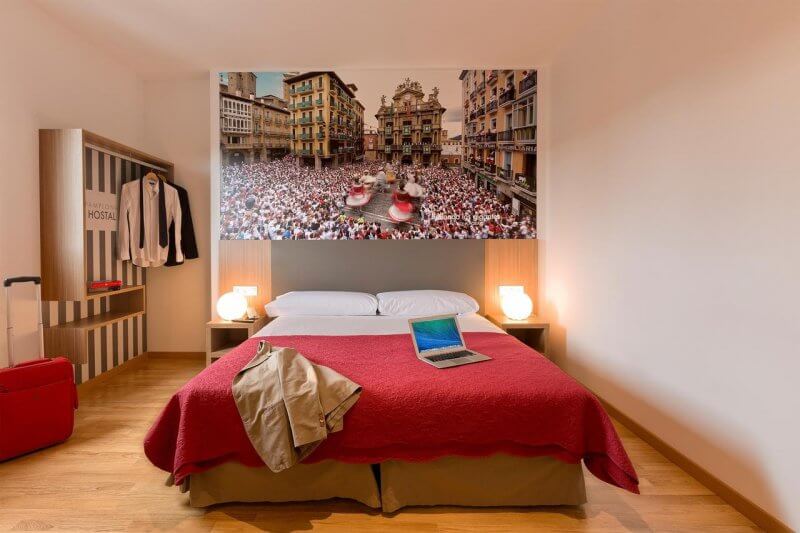
A tip! For the time of San Fermin, you need to book a hotel at least six months in advance.
| Price of a night in a hostel | Price of a double room in a 3* hotel per night | Cost of private family apartments | |
|---|---|---|---|
| During the year | from 20 € | 60 – 90 € | from 85 € |
| During San Fermin | from 65 € | 180 – 400 € | 400 – 1415 € |
Since Pamplona is small in size, you can stay in any part of the city, although it is most convenient in the historical center. This is where most hotels are located and offer many apartments.
How to get to Pamplona
The most convenient and cost-effective way to get to Pamplona is to fly to such big cities in Spain as Madrid or Barcelona, and then go by bus or train.
Travel by train
The most convenient and fastest way to get to Pamplona is by rail. It takes less than 4 hours to travel by direct high-speed train from Madrid and Barcelona. The cost of the trip is also approximately the same: 30-40 €.
From Madrid, trains to Pamplona run from Madrid-Puerta de Atocha Station.
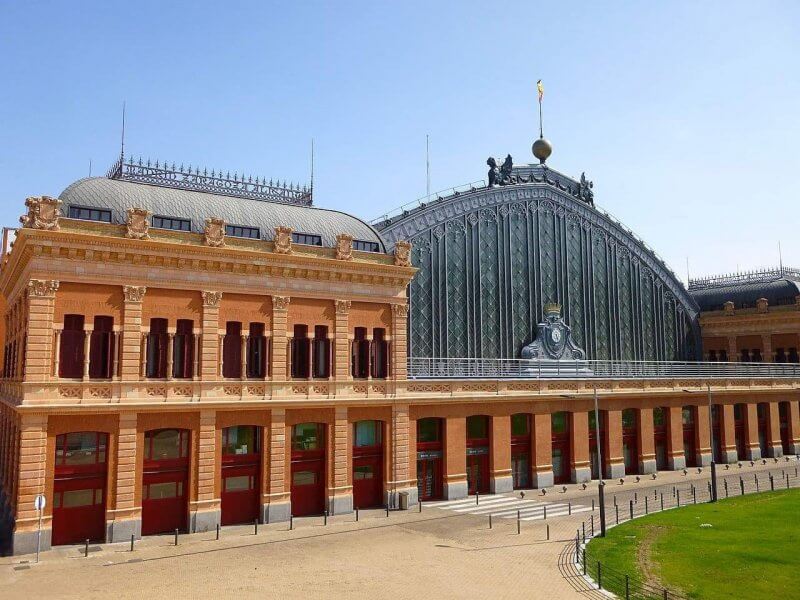
From Barcelona, trains to Pamplona depart from Barcelona Sants Station.
You can find out absolutely all the information about the railway transport schedule and buy tickets on the Spanish Railways website: www.renfe.com
Bus ride
Important! In Spain, bus drivers do not take stowaways for cash, so you should definitely buy a ticket! Tickets are sold on the websites and ticket offices of the bus station, as well as on the websites of the carrier company.
The bus to Pamplona takes 5-6 hours from Madrid, and almost 7 hours from Barcelona. Tickets from these cities will cost 35-60€, depending on the carrier company, departure time, and bus seat.
From Madrid, from the Madrid bus station, you can go with the carrier Alsa-website www.alsa.es.
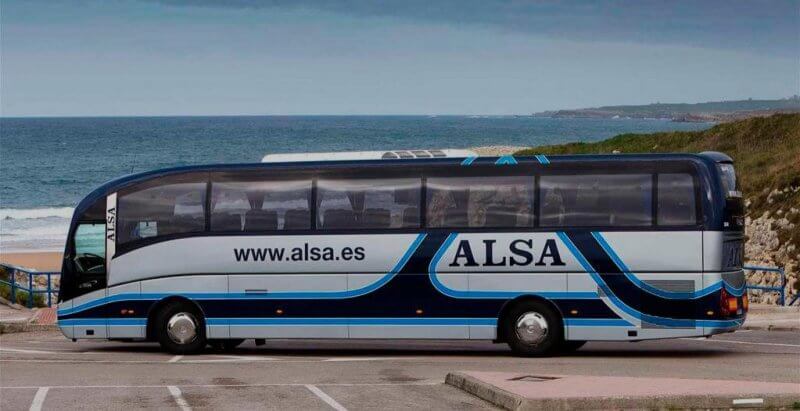
In Barcelona, buses to Pamplona depart from the Estacio de Nord and Sants bus stations. Transportation is handled by Vibasa-website www.busbud.com/en/bus-company/vibasa.
Important! At bus stations, you need to be very careful, because all buses, including those to Pamplona (Spain), often stop at other platforms.

